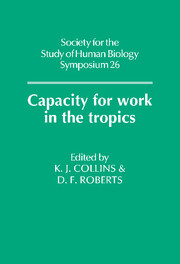Book contents
- Frontmatter
- Contents
- Preface
- Measurement of Working Capacity in Populations
- Functional Consequences of Malnutrition
- Growth, Stature and Muscular Efficiency
- Ethnic and Socio-Cultural Differences in Working Capacity
- Genetics of working capacity
- Working capacity in different African groups
- Environmental, genetic and leg mass influences on energy expenditure
- Sociocultural influences on the working capacity of elderly Nepali men
- Energy Expenditure and Endemic Disease
- Research Models in Tropical Ecosystems
- Index
Working capacity in different African groups
Published online by Cambridge University Press: 15 March 2010
- Frontmatter
- Contents
- Preface
- Measurement of Working Capacity in Populations
- Functional Consequences of Malnutrition
- Growth, Stature and Muscular Efficiency
- Ethnic and Socio-Cultural Differences in Working Capacity
- Genetics of working capacity
- Working capacity in different African groups
- Environmental, genetic and leg mass influences on energy expenditure
- Sociocultural influences on the working capacity of elderly Nepali men
- Energy Expenditure and Endemic Disease
- Research Models in Tropical Ecosystems
- Index
Summary
INTRODUCTION
The Utrecht group started its programme on working capacity and related parameters in African populations towards the end of the I.B.P. period. Part of this initial work has been published (Huizinga & Reijnders, 1974).
The population concerned was a group of 86 males, mainly consisting of members of the agricultural Fali, a Kirdi-tribe living in the mountainous region of North Cameroun between the 8th and 10th degree North latitude. They were studied in the neighbouring villages of NfGoutchoumi and Hama Koussou during the early months of 1970, i.e. during the dry season. The age of these volunteers ranged between 16 and 47 years.
As an ergo meter test, the double Master Ts step test has been chosen, as described in the I.B.P. handbook (Weiner & Lourie, 1969, p. 226). Heart frequency was determined at the ictus by auscultation; the number of beats was counted during 20 seconds immediately after each three-minute stepping period. No attempt was made to determine oxygen consumption directly. Instead, the 1954 nomogram of Åstrand and Ryhming was used to predict maximum aerobic power. General medical examination resulted in disqualification of eight individuals. Another 26 people performed badly and their results were discarded. Thus, the resulting 52 satisfactory tests, discussed previously (Huizinga & Reijnders, 1974) may be considered to represent those of selected males. Ever since, the relatively high values of aerobic power found (about 3.5 1/min and some 60 ml/kg/min) puzzled us.
- Type
- Chapter
- Information
- Capacity for Work in the Tropics , pp. 193 - 204Publisher: Cambridge University PressPrint publication year: 1988

